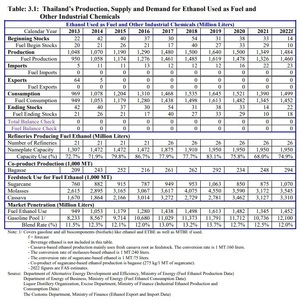Thailand's ethanol consumption remains below pre-COVID levels

August 15, 2022
BY Erin Krueger
Thailand’s consumption of fuel ethanol is expected to increase in 2022, but remain below pre-COVID levels, according to a report filed with the USDA Foreign Agricultural Service’s Global Agricultural Information Network.
According to the report, Thailand is expected to produce 1.484 billion liters (392.03 million gallons) of ethanol this year, including 1.46 billion liters of fuel ethanol, up from 1.349 billion liters and 1.326 billion liters, respectively, in 2021. Despite this growth, ethanol production is expected to remain below pre-COVID levels. In 2019, the country produced 1.64 billion liters of ethanol, including 1.619 billion liters of fuel ethanol.
The country currently has 26 ethanol plants, a number that has remained flat since 2017. Nameplate production capacity is expected to be at 1.95 billion liters this year, a level that has been maintained since 2019. Capacity use is expected to reach 74.9 percent in 2022, up from 68 percent in 2021, but below the 83.1 percent capacity use reported for 2019.
Advertisement
Advertisement
Molasses is expected to be the top ethanol feedstock used in Thailand this year, at 3.545 million metric tons, followed by cassava at 3.31 million metric tons and sugarcane at 1.07 million metric tons.
The GAIN report indicates that Thailand has not imported or exported any fuel ethanol during the past decade.
Ethanol consumption is expected to reach 1.499 billion liters this year, including 1.452 billion liters of fuel ethanol. Consumption was at 1.39 billion liters last year, including 1.345 billion liters of fuel ethanol. Thailand’s ethanol production peaked in 2019 at 1.645 billion liters, including 1.613 billion liters of fuel ethanol.
Advertisement
Advertisement
Ethanol is expected to account for 12 percent of Thailand’s gasoline pool in 2022, down from 12.5 percent in 2021, 12.7 percent in 2020, and 13.7 percent in 2019.
According to the report, Thailand consumed 10.763 billion liters of gasoline fuels last year. Approximately 10.354 billion liters of that volume was blended with ethanol, including 7.955 billion liters of E10 blends, 2.114 billion liters of E20 and 286 million liters of E85.
A full copy of the report can be downloaded from the USDA FAS GAIN website.
Related Stories
Neste Corp. on July 24 released second quarter results, reporting record quarterly renewable product sales volumes despite weaker margins. SAF sales were up nearly 80% when compared to the first quarter of 2025.
Valero Energy Corp. on July 24 released second quarter results, reporting a profitable three-month period for its ethanol segment. The renewable diesel segment posted a loss, but the company’s new sustainable aviation fuel (SAF) unit operated well.
The IRS on July 21 published a notice announcing the 2025 calendar-year inflation adjustment factor for the Section 45Z clen fuel production credit. The resulting adjustment boosts maximum the value of the credit by approximately 6%.
U.S. Secretary of Agriculture Brooke L. Rollins today announced the reorganization of the USDA, refocusing its core operations to better align with its founding mission of supporting American farming, ranching, and forestry.
The U.S. Department of Energy’s Office of Energy Efficiency and Renewable Energy is soliciting public comments on a preliminary plan for determining provisional emissions rates (PER) for the purposes of the 45Z clean fuel production credit.
Upcoming Events










